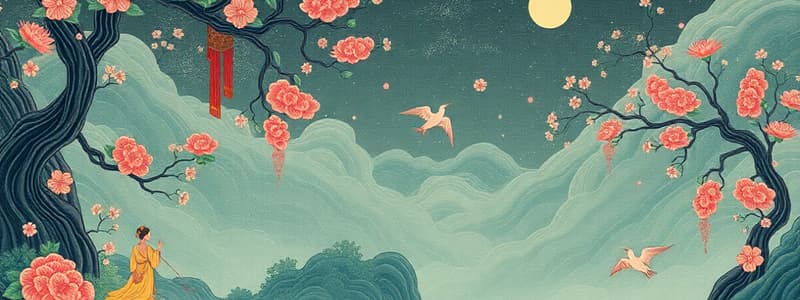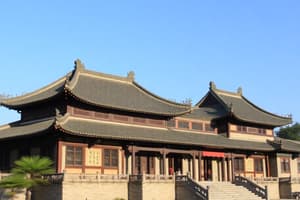Podcast
Questions and Answers
Which aspect of Chinese culture was most profoundly and enduringly shaped by the literature of its Golden Age?
Which aspect of Chinese culture was most profoundly and enduringly shaped by the literature of its Golden Age?
- The development of martial arts philosophies.
- The techniques used in landscape painting.
- The structure and operations of the Imperial bureaucracy.
- The everyday beliefs and traditions of the people. (correct)
How did the resurgence and subsequent decline of Buddhism during the Tang dynasty affect literary production?
How did the resurgence and subsequent decline of Buddhism during the Tang dynasty affect literary production?
- It led to a decrease in the production of philosophical texts and an increase in poetic works.
- It standardized the curriculum for the imperial examinations, limiting literary creativity.
- It caused the destruction of many previously written Confucian texts.
- It spurred intense philosophical debates, resulting in a significant increase in written religious and philosophical texts. (correct)
The period referred to as China's 'Golden Age', spanning the Sui, Tang, and Song dynasties, is primarily characterized by which of the following?
The period referred to as China's 'Golden Age', spanning the Sui, Tang, and Song dynasties, is primarily characterized by which of the following?
- Military dominance and territorial expansion across Asia.
- Rapid industrialization and technological advancements in manufacturing.
- Significant intellectual, cultural, and economic flourishing alongside political stability. (correct)
- Widespread adoption of Confucianism as the sole guiding philosophy and suppression of other ideologies.
What does the mention of the 'Farmer's Almanac' suggest about the readership of literary works during this period?
What does the mention of the 'Farmer's Almanac' suggest about the readership of literary works during this period?
The introduction of paper money during the Song dynasty significantly impacted Chinese commerce in which of the following ways?
The introduction of paper money during the Song dynasty significantly impacted Chinese commerce in which of the following ways?
Chinese landscape paintings from the Golden Age often depict humans and their structures as minor elements within a larger natural setting. This artistic choice primarily reflects which philosophical perspective?
Chinese landscape paintings from the Golden Age often depict humans and their structures as minor elements within a larger natural setting. This artistic choice primarily reflects which philosophical perspective?
What impact did the innovation of movable type have on literary production during the Tang dynasty?
What impact did the innovation of movable type have on literary production during the Tang dynasty?
Li Bo, Du Fu, and Su Shi are remembered for their poetry, but how did each contribute uniquely to the literary landscape of the Chinese Golden Age?
Li Bo, Du Fu, and Su Shi are remembered for their poetry, but how did each contribute uniquely to the literary landscape of the Chinese Golden Age?
Porcelain, perfected during China's Golden Age, became a highly valued export. Which combination of factors contributed most significantly to its widespread demand and prestige?
Porcelain, perfected during China's Golden Age, became a highly valued export. Which combination of factors contributed most significantly to its widespread demand and prestige?
The patronage of the arts by wealthy merchants during China's Golden Age indicates which broader socio-economic trend?
The patronage of the arts by wealthy merchants during China's Golden Age indicates which broader socio-economic trend?
Flashcards
China's Golden Age
China's Golden Age
A period of significant intellectual and cultural growth in China from 589 to 1271.
Chang'an
Chang'an
Served as the grandest city in the world during the Tang Dynasty.
Paper Money
Paper Money
New innovation of the Song Dynasty which facilitated trade throughout China.
Porcelain
Porcelain
Signup and view all the flashcards
Chinese Landscape Painting
Chinese Landscape Painting
Signup and view all the flashcards
Golden Age Literature
Golden Age Literature
Signup and view all the flashcards
Who was Li Bo?
Who was Li Bo?
Signup and view all the flashcards
Who was Du Fu?
Who was Du Fu?
Signup and view all the flashcards
Who was Su Shi?
Who was Su Shi?
Signup and view all the flashcards
Tang Dynasty Writing
Tang Dynasty Writing
Signup and view all the flashcards
Study Notes
- From 589 with the Sui dynasty to 1271 with the fall of the Song, China experienced considerable intellectual and cultural expansion.
- The Tang and Song dynasties are referred to as a 'Golden Age' due to their cultural output.
- During this time, China was stable, unified, and wealthy.
- The Tang capital of Chang'an was the world's grandest city.
- The Song capital of Kaifang was also impressive, located on the banks of the Grand Canal.
- The Grand Canal connected southern rice farmers with northern rice eaters.
- Merchants traded using paper money, a new innovation of the Song dynasty.
- Paper money had many advantages over coins.
- Tea, introduced from Southeast Asia, became one of the most important crops in China.
- Rich merchants became patrons to creative minds.
Art
- Chinese art reached its peak during this Golden Age.
- Porcelain, a fine form of pottery, was perfected and became a common export from China.
- Porcelain was glazed with detailed precision.
- Glazed ceramic objects were produced in large quantities, showcasing workmanship.
- Paintings from this period are highly valued.
- Chinese painters emphasized landscapes, minimizing the role of individuals.
- Humans are depicted as small and structures are in harmony with nature.
- Watercolors were used to create cohesive works that blend elements.
Literature
- Literature from this period has had a lasting impact on Chinese culture.
- Chinese poetry of this era was enlightened and diverse.
- Prominent poets include Li Bo, Du Fu, and Su Shi.
- Li Bo wrote about romance and alcohol and is rumored to have drowned while trying to touch the moon's reflection.
- Du Fu isRemembered for his imagery of imperial bureaucrat life.
- Su Shi isRemembered for the imagery he conveyed in his poems.
- Confucianism resurged during the Tang dynasty, leading to religious and philosophical texts.
- The innovation of movable type increased the production of written works.
- Farmer's Almanacs may have been read by local leaders of farming groups, suggesting a wider audience for publications.
Studying That Suits You
Use AI to generate personalized quizzes and flashcards to suit your learning preferences.




